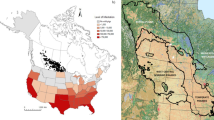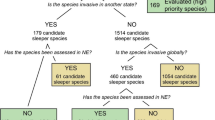Abstract
Climate change generally requires species to migrate northward or to higher elevation to maintain constant climate conditions, but migration requirement and migration capacity of individual species can vary greatly. Individual populations of species occupy different positions in the landscape that determine their required range shift to maintain similar climate, and likewise the migration capacity depends on habitat connectivity. Here, we demonstrate an approach to quantifying species vulnerabilities to climate change for 419 rare vascular plants in Alberta, Canada, based on a multivariate velocity of climate change metric, local habitat fragmentation, and migration capacity. Climate change velocities indicated that future migration requirements ranged from 1 to 5 km/year in topographically complex landscapes, such as the Alberta Foothills and Rocky Mountains. In contrast, migration requirements to maintain constant climate in relatively flat Boreal Plains, Parkland, and Grassland ranged from 4 to 8 km/year. Habitat fragmentation was also highest in these flat regions, particularly the Parkland Natural Region. Of the 419 rare vascular plants assessed, 36 were globally threatened (G1–G3 ranking). Three globally threatened species were ranked as extremely vulnerable and five species as highly vulnerable to the interactions among climate change velocity, habitat fragmentation, and migration capacity. Incorporating dispersal characteristics and habitat fragmentation with local patterns in climate change velocity improves the assessment of climate change threats to species and may be applied to guide monitoring efforts or conservation actions.





Similar content being viewed by others
References
ACIMS (Alberta Conservation Information Management System) (2013) Alberta environment and sustainable resource development. http://www.albertaparks.ca/albertaparksca/management-land-use/alberta-conservation-information-management-system-(acims)/download-data.aspx. Accessed Feb 2014
Alberta Biodiversity Monitoring Institute (2010) The ABMI GIS inventory of provincial human footprint, Version 1.1. http://www.abmi.ca/abmi/rawdata/geospatial/gisdownload.jsp?categoryId=3&subcategoryId=7. Accessed 9 June 2014
Bacles CFE, Lowe AJ, Ennos RA (2006) Effective seed dispersal across a fragmented landscape. Science 311:628. doi:10.1126/science.1121543
Beale CM, Lennon JJ, Gimona A (2008) Opening the climate envelope reveals no macroscale associations with climate in European birds. Proc Natl Acad Sci USA 105:14908–14912. doi:10.1073/pnas.0803506105
Beardmore T, Winder R (2011) Review of science-based assessments of species vulnerability: contributions to decision-making for assisted migration. For Chron 87:745–754
Burrows MT, Schoeman DS, Richardson AJ, Molinos JG, Hoffmann A, Buckley LB, Moore PJ, Brown CJ, Bruno JF, Duarte CM, Halpern BS, Hoegh-Guldberg O, Kappel CV, Kiessling W, O’Connor MI, Pandolfi JM, Parmesan C, Sydeman WJ, Ferrier S, Williams KJ, Poloczanska ES (2014) Geographical limits to species-range shifts are suggested by climate velocity. Nature 507:492–495. doi:10.1038/nature12976
Castilla G, Hird J, Hall RJ, Schieck J, McDermid G (2014) Completion and updating of a landsat-based land cover polygon layer for Alberta, Canada. Can J Remote Sens 40(2):92–109. doi:10.1080/07038992.2014.933073
Chen IC, Hill JK, Ohlemuller R, Roy DB, Thomas CD (2011) Rapid range shifts of species associated with high levels of climate warming. Science 333:1024–1026. doi:10.1126/science.1206432
Clark JS (1998) Why trees migrate so fast: confronting theory with dispersal biology and the paleorecord. Am Nat 152:204–224
Corlett RT (2011) Seed dispersal in Hong Kong, China: past, present and possible futures. Integr Zool 6:97–109. doi:10.1111/j.1749-4877.2011.00235.x
Coutts SR, Klinken RD, Yokomizo H, Buckley YM (2010) What are the key drivers of spread in invasive plants: dispersal, demography or landscape: and how can we use this knowledge to aid management? Biol Invasions 13:1649–1661. doi:10.1007/s10530-010-9922-5
Crimmins SM, Dobrowski SZ, Greenberg JA, Abatzoglou JT, Mynsberge AR (2011) Changes in climatic water balance drive downhill shifts in plant species’ optimum elevations. Science 331:324–327
Crooks KR, Burdett CL, Theobald DM, Rondinini C, Boitani L (2011) Global patterns of fragmentation and connectivity of mammalian carnivore habitat. Philos Trans R Soc Lond B Biol Sci 366:2642–2651. doi:10.1098/rstb.2011.0120
Daly C, Halbleib M, Smith JI, Gibson WP, Doggett MK, Taylor GH, Curtis J, Pasteris PP (2008) Physiographically sensitive mapping of climatological temperature and precipitation across the conterminous United States. Int J Climatol 28:2031–2064. doi:10.1002/joc.1688
Devictor V, van Swaay C, Brereton T, Brotons L, Chamberlain D, Heliola J, Herrando S, Julliard R, Kuussaari M, Lindstrom A, Reif J, Roy DB, Schweiger O, Settele J, Stefanescu C, Van Strien A, Van Turnhout C, Vermouzek Z, WallisDeVries M, Wynhoff I, Jiguet F (2012) Differences in the climatic debts of birds and butterflies at a continental scale. Nat Clim Change 2:121–124. doi:10.1038/nclimate1347
Dobrowski SZ, Abatzoglou J, Swanson AK, Greenberg JA, Mynsberge AR, Holden ZA, Schwartz MK (2013) The climate velocity of the contiguous United States during the twentieth century. Glob Change Biol 19:241–251. doi:10.1111/gcb.12026
Encyclopedia of Life (2014). http://www.eol.org. Accessed 15 Jan 2014
Feeley KJ, Silman MR, Bush MB, Farfan W, Cabrera KG, Malhi Y, Meir P, Revilla NS, Quisiyupanqui MNR, Saatchi S (2011) Upslope migration of Andean trees. J Biogeogr 38:783–791. doi:10.1111/j.1365-2699.2010.02444.x
Hamann A, Wang T, Spittlehouse DL, Murdock TQ (2013) A comprehensive, high-resolution database of historical and projected climate surfaces for western North America. Bull Am Meteorol Soc 94:1307–1309. doi:10.1175/bams-d-12-00145.1
Hamann A, Roberts DR, Barber QE, Carroll C, Nielsen SE (2014) Velocity of climate change algorithms for guiding conservation and management. Glob Change Biol 21:997–1004. doi:10.1111/gcb.12736
Howe HF, Smallwood J (1982) Ecology of seed dispersal. Annu Rev Ecol Syst 13:201–228. doi:10.2307/2097067
Hughes L (2000) Biological consequences of global warming: is the signal already apparent? Trends Ecol Evol 15:56–61. doi:10.1016/S0169-5347(99)01764-4
IPCC (2007) Climate change 2007: the physical science basis. In: Solomon S, Qin D, Manning M, Chen Z, Marquis M, Averyt KB, Tignor M, Miller HL (eds) Working Group I contribution to the fourth assessment report of the IPCC. Cambridge University Press, Cambridge and New York
IPCC (2014) Climate change 2014: impacts, adaptation, and vulnerability. In: Field CB, Barros VR, Dokken DJ, Mach KJ, Mastrandrea MD, Bilir TE, Chatterjee M, Ebi KL, Estrada YO, Genova RC, Girma B, Kissel ES, Levy AN, MacCracken S, Mastrandrea PR, White LL (eds) Part A: global and sectoral aspects. Contribution of working Group II to the fifth assessment report of the intergovernmental panel on climate change. Cambridge University Press, Cambridge and New York
Keane RE, Arno SF, Brown JK, Tomback DF (1990) Modelling stand dynamics in whitebark pine (Pinus albicaulis) forests. Ecol Model 51:73–95. doi:10.1016/0304-3800(90)90059-P
Kearney M, Porter W (2009) Mechanistic niche modelling: combining physiological and spatial data to predict species’ ranges. Ecol Lett 12:334–350. doi:10.1111/j.1461-0248.2008.01277.x
Loarie SR, Duffy PB, Hamilton H, Asner GP, Field CB, Ackerly DD (2009) The velocity of climate change. Nature 462:1052–1055. doi:10.1038/nature08649
Nathan R, Muller-Landau HC (2000) Spatial patterns of seed dispersal, their determinants and consequences for recruitment. Trends Ecol Evol 15:278–285
Natureserve (2014) NatureServe explorer: an online encyclopedia of life [web application]. Version 7.1. NatureServe. http://explorer.natureserve.org. Accessed 9 Oct 2014
Ordonez A, Williams J (2013) Projected climate reshuffling based on multivariate climate-availability, climate-analog, and climate-velocity analyses: implications for community disaggregation. Clim Change 119:659–675. doi:10.1007/s10584-013-0752-1
Pacifici M, Foden WB, Visconti P, Watson JEM, Butchart SHM, Kovacs KM, Scheffers BR, Hole DG, Martin TG, Akcakaya HR, Corlett RT, Huntley B, Bickford D, Carr JA, Hoffmann AA, Midgley GF, Pearce-Kelly P, Pearson RG, Williams SE, Willis SG, Young B, Rondinini C (2015) Assessing species vulnerability to climate change. Nat Clim Change 5:215–224. doi: 10.1038/nclimate2448. http://www.nature.com/nclimate/journal/v5/n3/abs/nclimate2448.html#supplementary-information
Parmesan C, Ryrholm N, Stefanescu C, Hill JK, Thomas CD, Descimon H, Huntley B, Kaila L, Kullberg J, Tammaru T, Tennent WJ, Thomas JA, Warren M (1999) Poleward shifts in geographical ranges of butterfly species associated with regional warming. Nature 399:37–42. doi:10.1038/21181
Pearson RG, Dawson TP (2003) Predicting the impacts of climate change on the distribution of species: are bioclimate envelope models useful? Glob Ecol Biogeogr 12:361–371
Peterson AT, Ortega-Huerta MA, Bartley J, Sanchez-Cordero V, Soberon J, Buddemeier RH, Stockwell DRB (2002) Future projections for Mexican faunas under global climate change scenarios. Nature 416:626–629
Pinsky ML, Worm B, Fogarty MJ, Sarmiento JL, Levin SA (2013) Marine taxa track local climate velocities. Science 341:1239–1242
Renton M, Childs S, Standish R, Shackelford N (2013) Plant migration and persistence under climate change in fragmented landscapes: does it depend on the key point of vulnerability within the lifecycle? Ecol Model 249:50–58. doi:10.1016/j.ecolmodel.2012.07.005
Savolainen O, Pyhäjärvi T, Knürr T (2007) Gene flow and local adaptation in trees. Annu Rev Ecol Evol Syst 38:595–619. doi:10.1146/annurev.ecolsys.38.091206.095646
Schwartz MW, Iverson LR, Prasad AM, Matthews SN, O’Connor RJ (2006) Predicting extinctions as a result of climate change. Ecology 87:1611–1615. doi:10.1890/0012-9658(2006)87
Schwartz MW, Hellmann JJ, McLachlan JM, Sax DF, Borevitz JO, Brennan J, Camacho AE, Ceballos G, Clark JR, Doremus H, Early R, Etterson JR, Fielder D, Gill JL, Gonzalez P, Green N, Hannah L, Jamieson DW, Javeline D, Minteer BA, Odenbaugh J, Polasky S, Richardson DM, Root TL, Safford HD, Sala O, Schneider SH, Thompson AR, Williams JW, Vellend M, Vitt P, Zellmer S (2012) Managed relocation: integrating the scientific, regulatory, and ethical challenges. Bioscience 62:732–743. doi:10.1525/bio.2012.62.8.6
Stralberg D, Matsuoka SM, Hamann A, Bayne EM, Sólymos P, Schmiegelow F, Wang X, Cumming SG, Song SJ (2014) Projecting boreal bird responses to climate change: the signal exceeds the noise. Ecol Appl 25:52–69. doi:10.1890/13-2289.1
Thomas CD, Cameron A, Green RE, Bakkenes M, Beaumont LJ, Collingham YC, Erasmus BF, De Siqueira MF, Grainger A, Hannah L, Hughes L, Huntley B, Van Jaarsveld AS, Midgley GF, Miles L, Ortega-Huerta MA, Peterson AT, Phillips OL, Williams SE (2004) Extinction risk from climate change. Nature 427:145–148. doi:10.1038/nature02121
Tingley MW, Koo MS, Moritz C, Rush AC, Beissinger SR (2012) The push and pull of climate change causes heterogeneous shifts in avian elevational ranges. Glob Change Biol 18:3279–3290. doi:10.1111/j.1365-2486.2012.02784.x
USDA, NRCS (2014) The PLANTS database. National Plant Data Team, Greensboro, NC, USA. http://plants.usda.gov. Accessed 27 June 2014
Vitt P, Havens K, Kramer AT, Sollenberger D, Yates E (2010) Assisted migration of plants: changes in latitudes, changes in attitudes. Biol Conserv 143:18–27. doi:10.1016/j.biocon.2009.08.015
Vittoz P, Engler R (2008) Seed dispersal distances: a typology based on dispersal modes and plant traits. Bot Helv 117:109–124. doi:10.1007/s00035-007-0797-8
Wang T, Hamann A, Spittlehouse DL, Murdock TQ (2012) ClimateWNA—high-resolution spatial climate data for western North America. J Appl Meteorol Climatol 51:16–29. doi:10.1175/jamc-d-11-043.1
Williams SE, Shoo LP, Isaac JL, Hoffmann AA, Langham G (2008) Towards an integrated framework for assessing the vulnerability of species to climate change. PLoS Biol 6:e325. doi:10.1371/journal.pbio.0060325
Young B, Byers E, Gravuer K, Hall K, Hammerson G, Redder A (2011) Guidelines for using the NatureServe climate change vulnerability index. Version 2:1
Zhu K, Woodall CW, Clark JS (2012) Failure to migrate: lack of tree range expansion in response to climate change. Glob Change Biol 18:1042–1052. doi:10.1111/j.1365-2486.2011.02571.x
Acknowledgments
We thank David Roberts for contributing spatial data to this analysis. We thank the Alberta Biodiversity Monitoring Institute (ABMI) and Climate Change Emissions Management Corporation (CCEMC) project for feedback. This research was funded by the Wilburforce Foundation Grant 1304 to SEN, and a Canadian Natural Sciences and the Engineering Research Council (NSERC) Discovery Grant RGPIN-330527-07 to AH.
Author information
Authors and Affiliations
Corresponding author
Additional information
Editor: James Pittock.
Electronic supplementary material
Below is the link to the electronic supplementary material.
Rights and permissions
About this article
Cite this article
Barber, Q.E., Nielsen, S.E. & Hamann, A. Assessing the vulnerability of rare plants using climate change velocity, habitat connectivity, and dispersal ability: a case study in Alberta, Canada. Reg Environ Change 16, 1433–1441 (2016). https://doi.org/10.1007/s10113-015-0870-6
Received:
Accepted:
Published:
Issue Date:
DOI: https://doi.org/10.1007/s10113-015-0870-6




